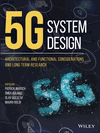Network Slicing
Gerd Zimmermann
Deutsche Telekom AG, Technology Innovation, Germany
Search for more papers by this authorJakob Belschner
Deutsche Telekom AG, Technology Innovation, Germany
Search for more papers by this authorAnna Tzanakaki
National and Kapodistrian University of Athens, Greece and University of Bristol, UK
Search for more papers by this authorPaul Arnold
Deutsche Telekom AG, Technology Innovation, Germany
Search for more papers by this authorGerd Zimmermann
Deutsche Telekom AG, Technology Innovation, Germany
Search for more papers by this authorJakob Belschner
Deutsche Telekom AG, Technology Innovation, Germany
Search for more papers by this authorAnna Tzanakaki
National and Kapodistrian University of Athens, Greece and University of Bristol, UK
Search for more papers by this authorPaul Arnold
Deutsche Telekom AG, Technology Innovation, Germany
Search for more papers by this authorSummary
This chapter contains a comprehensive summary and analysis of the latest 3rd Generation Partnership Project (3GPP) specifications and also findings from several 5G Public-Private Partnership (5G PPP) research projects. It provides detailed information for each network domain, as well as for the support of slicing across different operator administrative domains. Technological specificities of each domain require addressing different key issues for the realization of the slicing concept. The chapter discusses a realistic end-to-end (E2E) example of network slicing. Several slice operation aspects such as slice selection and isolation, context transfer, slice orchestration and management are presented. It also provides additional details on a number of slice operational aspects such as slice selection, connectivity to multiple slices, inter-slice radio resource management (RRM) functions, and the overall management of network slices. Finally, the chapter summarizes the key findings and also lists the technical challenges that still remain open.
References
- 3GPP TS 23.501, “ System Architecture for the 5G System; Stage 2 (Release 15)”, Version 15.0.0, December 2017
- 3GPP TR 38.801, “ Study on New Radio Access Technology; Radio Access Architecture and Interfaces (Release 14)”, Version 14.0.0, March 2017
- 3GPP TR 23.799, “ Study on New Radio Access Technology; Radio Access Architecture and Interfaces (Release 14)”, Version 14.0.0, December 2016
- NGMN Alliance, “ Description of Network Slicing Concept”, January 2016
- 5G PPP 5G NORMA project, Deliverable D3.3, “ 5G NORMA network architecture – final report”, Oct. 2017.
- ETSI, Industry Specification Group (ISG) Network Functions Virtualization (NFV), see http://www.etsi.org/technologies-clusters/technologies/nfv
- B. Blanco et al., “ Technology pillars in the architecture of future 5G mobile networks: NFV, MEC and SDN ”, Computer Standards and Interfaces, January 2017
- M. Richart J. Baliosian, J. Serrat and J-L Gorricho, “Resource Slicing in Virtual Wireless Networks: A Survey”, IEEE Transactions of Network and Service Management, vol. 13, no. 3, Sept. 2016
- C. Liang and F.R. Wu, “Wireless Network Virtualization: A Survey, some research issues and challenges”, IEEE Communication Surveys and Tutorials, vol 17, no. 1, Q1 2015
- NGMN Alliance, White Paper, “ 5G White Paper”, Version 1.0, March 2015
- 5G PPP Architecture Working Group, White Paper “ View on 5G Architecture”, Version 1.0, July 2016
- 3GPP TS 23.251, “ Network Sharing; Architecture and functional description (Release 14)”, Version 14.0.0, March 2017
- 3GPP TR 23.707, “ Architecture Enhancements for Dedicated Core Networks; Stage 2 (Release 13)”, Version 14.0.0, Dec. 2014
- 3GPP TR 23.711, “ Enhancements of Dedicated Core Networks selection mechanism (Release 14)”, Version 14.0.0, Sept. 2016
- ETSI ISG Mobile Edge Computing (MEC), see http://www.etsi.org/technologies-clusters/technologies/multi-access-edge-computing
- 3GPP TS 23.214, “ Architecture enhancements for control and user plane separation of EPC nodes; Stage 2 (Release 14)”, Version 14.3.0, June 2017
- 3GPP TS 23.502, “ Procedures for the 5G System; Stage 2 (Release 15)”, Version 15.0.0, December 2017
- 3GPP TR 33.899, “ Study on the security aspects of the next generation system”, Version 1.2.0, June 2017
- Anna Tzanakaki et al, “ Wireless-Optical Network Convergence: Enabling the 5G Architecture to Support Operational and End-User Services”, IEEE Communications Magazine (to appear)
- 3GPP TS 38.300 “ NR and NG-RAN Overall Desciption”, Release 15, Version 1.2.0, May 2017
- Adlen Ksentini and Navid Nikaein, “Toward enforcing network slicing on RAN: Flexibility and resources abstraction”, IEEE Communications Magazine, vol. 55, no. 6, June 2017
- 5G PPP METIS-II project, White Paper, “ Preliminary Views and Initial Considerations on 5G RAN Architecture and Functional Design”, March 2016
- P. Marsch et al., “5G radio access network architecture: design guidelines and key considerations”, IEEE Communications Magazine, vol. 54, no. 11, pp. 24–32, Nov. 2016
- 3GPP TR 38.912, “ Study on New Radio (NR) access technology”, Release 14, Version 14.0.0, March 2017
- 5G PPP 5GEx project, White paper, “ 5GEx Multi-domain Service Creation - from 90 days to 90 minutes”, March 2016
- 5G PPP 5GEx project, Deliverable D3.1, “ Description of protocol and component design”, July 2016
- X. An, C. Zhou, R. Trivisonno, R. Guerzoni, A. Kaloxylos, D. Soldani and A. Hecker, “ On end to end network slicing for 5G ”, Transactions on Emerging Telecommunications Technologies, Wiley, June 2016
- I. da Silva et al., “ Impact of network slicing on 5G Radio Access Networks”, European Conference on Networks and Communications (EuCNC 2016), June 2016
- 3GPP TS 22.011, “ Service Accessibility (Release 15)”, Version 15.1.0, June 2017
- 3GPP TR 28.801, “ Study on management and orchestration of network slicing for next generation networks”, Release 15, Version 15.0.0, September 2017



